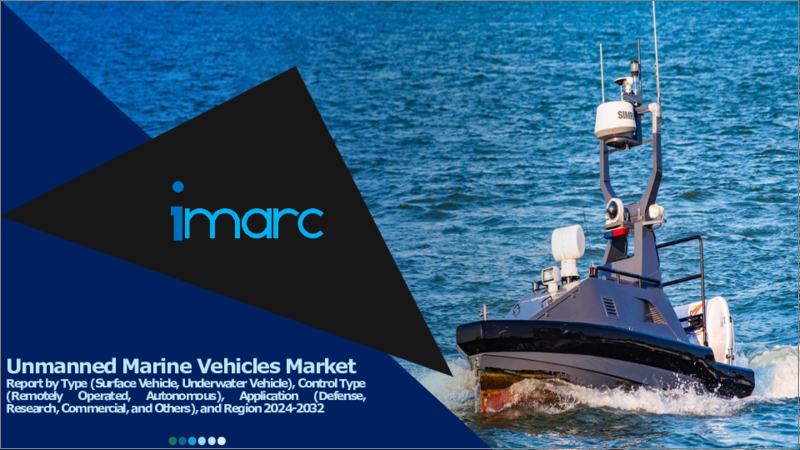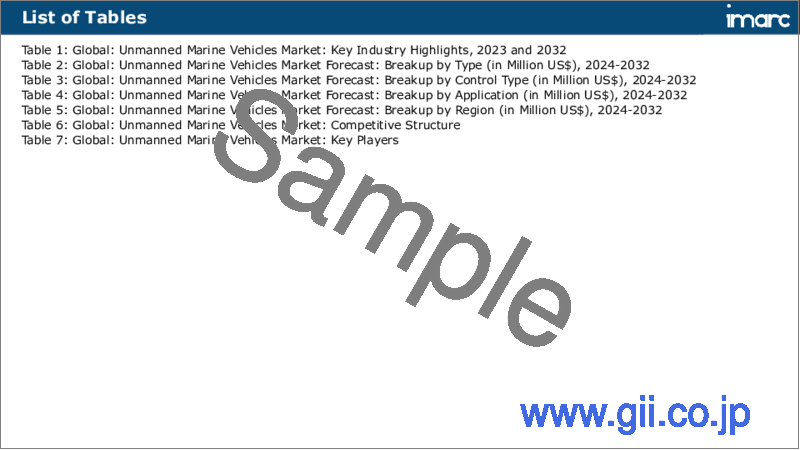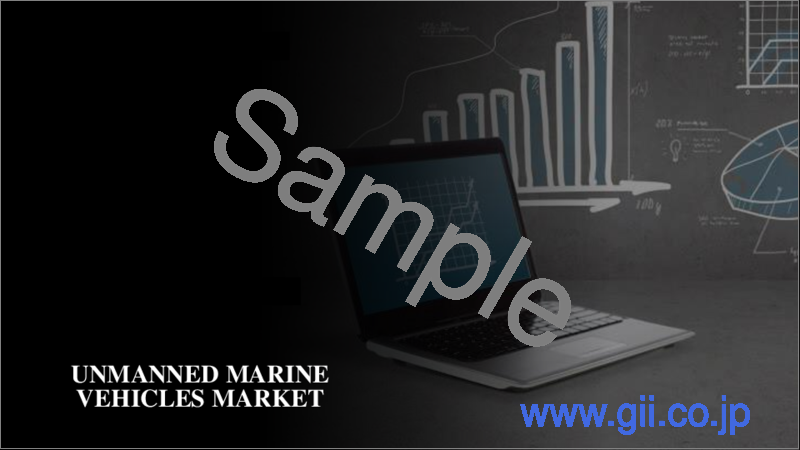|
|
市場調査レポート
商品コード
1541677
無人船舶市場レポート:タイプ別、制御タイプ別、用途別、地域別、2024~2032年Unmanned Marine Vehicles Market Report by Type (Surface Vehicle, Underwater Vehicle), Control Type (Remotely Operated, Autonomous), Application (Defense, Research, Commercial, and Others), and Region 2024-2032 |
||||||
カスタマイズ可能
|
|||||||
| 無人船舶市場レポート:タイプ別、制御タイプ別、用途別、地域別、2024~2032年 |
|
出版日: 2024年08月10日
発行: IMARC
ページ情報: 英文 149 Pages
納期: 2~3営業日
|
- 全表示
- 概要
- 図表
- 目次
世界の無人船舶市場規模は2023年に44億米ドルに達しました。今後、IMARC Groupは、市場は2032年までに102億米ドルに達し、2024~2032年の間に9.6%の成長率(CAGR)を示すと予測しています。
無人船舶(UMV)とは、人間の介入なしに水面上や水面下で遠隔操作や自動操縦が可能なロボット船舶システムを指します。標準的な船舶タイプとしては、無人水上艇、半潜水艇、遠隔操作・自律型水中車両などがあります。これらの軍用システムは小型船から中型船まであり、周辺地域の環境関連データを取得・記録し、車両の反応や進路を評価するのに役立つ複数のセンサーを装備しています。UMVは、海洋動物のモニタリングの向上、軍事関連の危険な作業の自動実行、安全性の提供、最小限の運用コストでの調査期間の短縮などに役立っています。また、UMVは安定性と操縦性に優れているため、海洋学や水路学のデータ収集、深海での採掘、対潜水艦戦(ASW)などの用途に使用されています。
無人船舶市場動向
軍需部門の海軍・国防部門における急速な拡大と、情報・監視・偵察(ISR)活動のための自律型水中・遠隔操作船舶(AUVs/ROVs)に対するニーズの高まりが、主に市場成長の原動力となっています。さらに、魚雷の危険性、水中機雷、ディーゼル電気潜水艦の攻撃、短距離対艦ミサイルなどの海洋安全保障上の脅威に対処するための各国政府による防衛軍への大規模な投資が、もう一つの成長促進要因として作用しています。これに伴い、船舶の安全な航行のための海図作成や港湾開拓のための淡水環境把握のための水路調査における自律型海上車両の普及が市場の成長を支えています。さらに、水中ナビゲーションシステム、安定化武器ソリューション、赤外線ビジョンを使って水中環境を監視するための電気光学追跡装置とUMVの大規模な統合が市場成長を促進しています。これとは別に、潜在的な水中の脅威を無力化するための主要企業によるロボットプラットフォームの開拓が、市場の成長を積極的に後押ししています。
本レポートで扱う主要質問
- 世界の無人船舶市場はこれまでどのように推移し、今後どのように推移するのか?
- COVID-19は世界の無人船舶市場にどのような影響を与えたか?
- 主要地域市場とは?
- タイプ別の市場内訳は?
- 制御タイプ別の市場内訳は?
- 用途別の市場内訳は?
- 業界のバリューチェーンにおける様々なステージとは?
- 業界の主要な促進要因と課題は何か?
- 世界の無人船舶市場の構造と主要参入企業は?
- 業界の競合の程度は?
目次
第1章 序文
第2章 調査範囲と調査手法
- 調査の目的
- ステークホルダー
- データソース
- 一次情報
- 二次情報
- 市場推定
- ボトムアップアプローチ
- トップダウンアプローチ
- 調査手法
第3章 エグゼクティブサマリー
第4章 イントロダクション
- 概要
- 主要業界動向
第5章 世界の無人船舶市場
- 市場概要
- 市場実績
- COVID-19の影響
- 市場予測
第6章 市場内訳:タイプ別
- 水上
- 水中
第7章 市場内訳:制御タイプ別
- 遠隔操作型
- 自律型
第8章 市場内訳:用途別
- 防衛
- 研究
- 商用
- その他
第9章 市場内訳:地域別
- 北米
- 米国
- カナダ
- アジア太平洋
- 中国
- 日本
- インド
- 韓国
- オーストラリア
- インドネシア
- その他
- 欧州
- ドイツ
- フランス
- 英国
- イタリア
- スペイン
- ロシア
- その他
- ラテンアメリカ
- ブラジル
- メキシコ
- その他
- 中東・アフリカ
- 市場動向
- 市場内訳:国別
- 市場予測
第10章 SWOT分析
- 概要
- 強み
- 弱み
- 機会
- 脅威
第11章 バリューチェーン分析
第12章 ポーターのファイブフォース分析
- 概要
- 買い手の交渉力
- 供給企業の交渉力
- 競合の程度
- 新規参入業者の脅威
- 代替品の脅威
第13章 価格分析
第14章 競合情勢
- 市場構造
- 主要企業
- 主要企業のプロファイル
- Atlas Elektronik GmbH(ThyssenKrupp AG)
- Fugro
- General Dynamics Mission Systems Inc.(General Dynamics Corporation)
- Kongsberg Gruppen
- L3harris Technologies Inc.
- Lockheed Martin Corporation
- QinetiQ
- Rafael Advanced Defense Systems Ltd.
- Saab AB
- Teledyne Technologies Inc.
- Textron Inc.
- The Boeing Company
List of Figures
- Figure 1: Global: Unmanned Marine Vehicles Market: Major Drivers and Challenges
- Figure 2: Global: Unmanned Marine Vehicles Market: Sales Value (in Billion US$), 2018-2023
- Figure 3: Global: Unmanned Marine Vehicles Market Forecast: Sales Value (in Billion US$), 2024-2032
- Figure 4: Global: Unmanned Marine Vehicles Market: Breakup by Type (in %), 2023
- Figure 5: Global: Unmanned Marine Vehicles Market: Breakup by Control Type (in %), 2023
- Figure 6: Global: Unmanned Marine Vehicles Market: Breakup by Application (in %), 2023
- Figure 7: Global: Unmanned Marine Vehicles Market: Breakup by Region (in %), 2023
- Figure 8: Global: Unmanned Marine Vehicles (Surface Vehicle) Market: Sales Value (in Million US$), 2018 & 2023
- Figure 9: Global: Unmanned Marine Vehicles (Surface Vehicle) Market Forecast: Sales Value (in Million US$), 2024-2032
- Figure 10: Global: Unmanned Marine Vehicles (Underwater Vehicle) Market: Sales Value (in Million US$), 2018 & 2023
- Figure 11: Global: Unmanned Marine Vehicles (Underwater Vehicle) Market Forecast: Sales Value (in Million US$), 2024-2032
- Figure 12: Global: Unmanned Marine Vehicles (Remotely Operated) Market: Sales Value (in Million US$), 2018 & 2023
- Figure 13: Global: Unmanned Marine Vehicles (Remotely Operated) Market Forecast: Sales Value (in Million US$), 2024-2032
- Figure 14: Global: Unmanned Marine Vehicles (Autonomous) Market: Sales Value (in Million US$), 2018 & 2023
- Figure 15: Global: Unmanned Marine Vehicles (Autonomous) Market Forecast: Sales Value (in Million US$), 2024-2032
- Figure 16: Global: Unmanned Marine Vehicles (Defense) Market: Sales Value (in Million US$), 2018 & 2023
- Figure 17: Global: Unmanned Marine Vehicles (Defense) Market Forecast: Sales Value (in Million US$), 2024-2032
- Figure 18: Global: Unmanned Marine Vehicles (Research) Market: Sales Value (in Million US$), 2018 & 2023
- Figure 19: Global: Unmanned Marine Vehicles (Research) Market Forecast: Sales Value (in Million US$), 2024-2032
- Figure 20: Global: Unmanned Marine Vehicles (Commercial) Market: Sales Value (in Million US$), 2018 & 2023
- Figure 21: Global: Unmanned Marine Vehicles (Commercial) Market Forecast: Sales Value (in Million US$), 2024-2032
- Figure 22: Global: Unmanned Marine Vehicles (Other Applications) Market: Sales Value (in Million US$), 2018 & 2023
- Figure 23: Global: Unmanned Marine Vehicles (Other Applications) Market Forecast: Sales Value (in Million US$), 2024-2032
- Figure 24: North America: Unmanned Marine Vehicles Market: Sales Value (in Million US$), 2018 & 2023
- Figure 25: North America: Unmanned Marine Vehicles Market Forecast: Sales Value (in Million US$), 2024-2032
- Figure 26: United States: Unmanned Marine Vehicles Market: Sales Value (in Million US$), 2018 & 2023
- Figure 27: United States: Unmanned Marine Vehicles Market Forecast: Sales Value (in Million US$), 2024-2032
- Figure 28: Canada: Unmanned Marine Vehicles Market: Sales Value (in Million US$), 2018 & 2023
- Figure 29: Canada: Unmanned Marine Vehicles Market Forecast: Sales Value (in Million US$), 2024-2032
- Figure 30: Asia-Pacific: Unmanned Marine Vehicles Market: Sales Value (in Million US$), 2018 & 2023
- Figure 31: Asia-Pacific: Unmanned Marine Vehicles Market Forecast: Sales Value (in Million US$), 2024-2032
- Figure 32: China: Unmanned Marine Vehicles Market: Sales Value (in Million US$), 2018 & 2023
- Figure 33: China: Unmanned Marine Vehicles Market Forecast: Sales Value (in Million US$), 2024-2032
- Figure 34: Japan: Unmanned Marine Vehicles Market: Sales Value (in Million US$), 2018 & 2023
- Figure 35: Japan: Unmanned Marine Vehicles Market Forecast: Sales Value (in Million US$), 2024-2032
- Figure 36: India: Unmanned Marine Vehicles Market: Sales Value (in Million US$), 2018 & 2023
- Figure 37: India: Unmanned Marine Vehicles Market Forecast: Sales Value (in Million US$), 2024-2032
- Figure 38: South Korea: Unmanned Marine Vehicles Market: Sales Value (in Million US$), 2018 & 2023
- Figure 39: South Korea: Unmanned Marine Vehicles Market Forecast: Sales Value (in Million US$), 2024-2032
- Figure 40: Australia: Unmanned Marine Vehicles Market: Sales Value (in Million US$), 2018 & 2023
- Figure 41: Australia: Unmanned Marine Vehicles Market Forecast: Sales Value (in Million US$), 2024-2032
- Figure 42: Indonesia: Unmanned Marine Vehicles Market: Sales Value (in Million US$), 2018 & 2023
- Figure 43: Indonesia: Unmanned Marine Vehicles Market Forecast: Sales Value (in Million US$), 2024-2032
- Figure 44: Others: Unmanned Marine Vehicles Market: Sales Value (in Million US$), 2018 & 2023
- Figure 45: Others: Unmanned Marine Vehicles Market Forecast: Sales Value (in Million US$), 2024-2032
- Figure 46: Europe: Unmanned Marine Vehicles Market: Sales Value (in Million US$), 2018 & 2023
- Figure 47: Europe: Unmanned Marine Vehicles Market Forecast: Sales Value (in Million US$), 2024-2032
- Figure 48: Germany: Unmanned Marine Vehicles Market: Sales Value (in Million US$), 2018 & 2023
- Figure 49: Germany: Unmanned Marine Vehicles Market Forecast: Sales Value (in Million US$), 2024-2032
- Figure 50: France: Unmanned Marine Vehicles Market: Sales Value (in Million US$), 2018 & 2023
- Figure 51: France: Unmanned Marine Vehicles Market Forecast: Sales Value (in Million US$), 2024-2032
- Figure 52: United Kingdom: Unmanned Marine Vehicles Market: Sales Value (in Million US$), 2018 & 2023
- Figure 53: United Kingdom: Unmanned Marine Vehicles Market Forecast: Sales Value (in Million US$), 2024-2032
- Figure 54: Italy: Unmanned Marine Vehicles Market: Sales Value (in Million US$), 2018 & 2023
- Figure 55: Italy: Unmanned Marine Vehicles Market Forecast: Sales Value (in Million US$), 2024-2032
- Figure 56: Spain: Unmanned Marine Vehicles Market: Sales Value (in Million US$), 2018 & 2023
- Figure 57: Spain: Unmanned Marine Vehicles Market Forecast: Sales Value (in Million US$), 2024-2032
- Figure 58: Russia: Unmanned Marine Vehicles Market: Sales Value (in Million US$), 2018 & 2023
- Figure 59: Russia: Unmanned Marine Vehicles Market Forecast: Sales Value (in Million US$), 2024-2032
- Figure 60: Others: Unmanned Marine Vehicles Market: Sales Value (in Million US$), 2018 & 2023
- Figure 61: Others: Unmanned Marine Vehicles Market Forecast: Sales Value (in Million US$), 2024-2032
- Figure 62: Latin America: Unmanned Marine Vehicles Market: Sales Value (in Million US$), 2018 & 2023
- Figure 63: Latin America: Unmanned Marine Vehicles Market Forecast: Sales Value (in Million US$), 2024-2032
- Figure 64: Brazil: Unmanned Marine Vehicles Market: Sales Value (in Million US$), 2018 & 2023
- Figure 65: Brazil: Unmanned Marine Vehicles Market Forecast: Sales Value (in Million US$), 2024-2032
- Figure 66: Mexico: Unmanned Marine Vehicles Market: Sales Value (in Million US$), 2018 & 2023
- Figure 67: Mexico: Unmanned Marine Vehicles Market Forecast: Sales Value (in Million US$), 2024-2032
- Figure 68: Others: Unmanned Marine Vehicles Market: Sales Value (in Million US$), 2018 & 2023
- Figure 69: Others: Unmanned Marine Vehicles Market Forecast: Sales Value (in Million US$), 2024-2032
- Figure 70: Middle East and Africa: Unmanned Marine Vehicles Market: Sales Value (in Million US$), 2018 & 2023
- Figure 71: Middle East and Africa: Unmanned Marine Vehicles Market: Breakup by Country (in %), 2023
- Figure 72: Middle East and Africa: Unmanned Marine Vehicles Market Forecast: Sales Value (in Million US$), 2024-2032
- Figure 73: Global: Unmanned Marine Vehicles Industry: SWOT Analysis
- Figure 74: Global: Unmanned Marine Vehicles Industry: Value Chain Analysis
- Figure 75: Global: Unmanned Marine Vehicles Industry: Porter's Five Forces Analysis
List of Tables
- Table 1: Global: Unmanned Marine Vehicles Market: Key Industry Highlights, 2023 and 2032
- Table 2: Global: Unmanned Marine Vehicles Market Forecast: Breakup by Type (in Million US$), 2024-2032
- Table 3: Global: Unmanned Marine Vehicles Market Forecast: Breakup by Control Type (in Million US$), 2024-2032
- Table 4: Global: Unmanned Marine Vehicles Market Forecast: Breakup by Application (in Million US$), 2024-2032
- Table 5: Global: Unmanned Marine Vehicles Market Forecast: Breakup by Region (in Million US$), 2024-2032
- Table 6: Global: Unmanned Marine Vehicles Market: Competitive Structure
- Table 7: Global: Unmanned Marine Vehicles Market: Key Players
The global unmanned marine vehicles market size reached US$ 4.4 Billion in 2023. Looking forward, IMARC Group expects the market to reach US$ 10.2 Billion by 2032, exhibiting a growth rate (CAGR) of 9.6% during 2024-2032.
Unmanned marine vehicles (UMVs) refer to robotic vessel systems that can be operated above and below the water surface remotely or automatically without any human intervention. It includes unmanned surface craft, semi-submersibles, and remotely operated and autonomous underwater vehicles as some standard vessel types. These military systems can range from small vessels to mid-sized ships, and they are equipped with several sensors that help acquire and record environment-related data of nearby areas and assess vehicle response or course. UMVs assist in improving marine animal monitoring, performing risky military-related tasks automatically, offering safety, and reducing survey duration at minimal operational costs. Apart from this, UMVs are stable and maneuverable; therefore, they are used in oceanographic or hydrographic data collection, deep-sea mining, and anti-submarine warfare (ASW) applications.
Unmanned Marine Vehicles Market Trends:
The rapid expansion in the navy and defense department of the military sector and the increasing need for autonomous underwater and remotely operated vehicles (AUVs/ROVs) for intelligence, surveillance, and reconnaissance (ISR) operations are primarily driving the market growth. Additionally, extensive investments by governments in defense forces to deal with maritime-security threats, such as torpedo dangers, underwater mines, diesel-electric submarine attacks, and short-range anti-ship missiles, are acting as another growth-inducing factor. In line with this, the widespread uptake of autonomous marine vehicles in hydrographic surveys to produce navigational charts for safer transit of vessels and understand the freshwater environment for port and harbor development is supporting the market growth. Moreover, the large-scale integration of UMVs with underwater navigation systems, stabilized weapon solutions, and electro-optical tracking devices to monitor the aquatic environment using infrared vision is propelling the market growth. Apart from this, the development of robotic platforms by key players to neutralize potential underwater threats are positively augmenting the market growth.
Key Market Segmentation:
IMARC Group provides an analysis of the key trends in each sub-segment of the global unmanned marine vehicles market report, along with forecasts at the global, regional and country level from 2024-2032. Our report has categorized the market based on type, control type and application.
Breakup by Type:
Surface Vehicle
Underwater Vehicle
Breakup by Control Type:
Remotely Operated
Autonomous
Breakup by Application:
Defense
Research
Commercial
Others
Breakup by Region:
North America
United States
Canada
Asia-Pacific
China
Japan
India
South Korea
Australia
Indonesia
Others
Europe
Germany
France
United Kingdom
Italy
Spain
Russia
Others
Latin America
Brazil
Mexico
Others
Middle East and Africa
Competitive Landscape:
The competitive landscape of the industry has also been examined along with the profiles of the key players being Atlas Elektronik GmbH (ThyssenKrupp AG), Fugro, General Dynamics Mission Systems Inc. (General Dynamics Corporation), Kongsberg Gruppen, L3harris Technologies Inc., Lockheed Martin Corporation, QinetiQ, Rafael Advanced Defense Systems Ltd., Saab AB, Teledyne Technologies Inc., Textron Inc. and The Boeing Company.
Key Questions Answered in This Report:
- How has the global unmanned marine vehicles market performed so far and how will it perform in the coming years?
- What has been the impact of COVID-19 on the global unmanned marine vehicles market?
- What are the key regional markets?
- What is the breakup of the market based on the type?
- What is the breakup of the market based on the control type?
- What is the breakup of the market based on the application?
- What are the various stages in the value chain of the industry?
- What are the key driving factors and challenges in the industry?
- What is the structure of the global unmanned marine vehicles market and who are the key players?
- What is the degree of competition in the industry?
Table of Contents
1 Preface
2 Scope and Methodology
- 2.1 Objectives of the Study
- 2.2 Stakeholders
- 2.3 Data Sources
- 2.3.1 Primary Sources
- 2.3.2 Secondary Sources
- 2.4 Market Estimation
- 2.4.1 Bottom-Up Approach
- 2.4.2 Top-Down Approach
- 2.5 Forecasting Methodology
3 Executive Summary
4 Introduction
- 4.1 Overview
- 4.2 Key Industry Trends
5 Global Unmanned Marine Vehicles Market
- 5.1 Market Overview
- 5.2 Market Performance
- 5.3 Impact of COVID-19
- 5.4 Market Forecast
6 Market Breakup by Type
- 6.1 Surface Vehicle
- 6.1.1 Market Trends
- 6.1.2 Market Forecast
- 6.2 Underwater Vehicle
- 6.2.1 Market Trends
- 6.2.2 Market Forecast
7 Market Breakup by Control Type
- 7.1 Remotely Operated
- 7.1.1 Market Trends
- 7.1.2 Market Forecast
- 7.2 Autonomous
- 7.2.1 Market Trends
- 7.2.2 Market Forecast
8 Market Breakup by Application
- 8.1 Defense
- 8.1.1 Market Trends
- 8.1.2 Market Forecast
- 8.2 Research
- 8.2.1 Market Trends
- 8.2.2 Market Forecast
- 8.3 Commercial
- 8.3.1 Market Trends
- 8.3.2 Market Forecast
- 8.4 Others
- 8.4.1 Market Trends
- 8.4.2 Market Forecast
9 Market Breakup by Region
- 9.1 North America
- 9.1.1 United States
- 9.1.1.1 Market Trends
- 9.1.1.2 Market Forecast
- 9.1.2 Canada
- 9.1.2.1 Market Trends
- 9.1.2.2 Market Forecast
- 9.1.1 United States
- 9.2 Asia-Pacific
- 9.2.1 China
- 9.2.1.1 Market Trends
- 9.2.1.2 Market Forecast
- 9.2.2 Japan
- 9.2.2.1 Market Trends
- 9.2.2.2 Market Forecast
- 9.2.3 India
- 9.2.3.1 Market Trends
- 9.2.3.2 Market Forecast
- 9.2.4 South Korea
- 9.2.4.1 Market Trends
- 9.2.4.2 Market Forecast
- 9.2.5 Australia
- 9.2.5.1 Market Trends
- 9.2.5.2 Market Forecast
- 9.2.6 Indonesia
- 9.2.6.1 Market Trends
- 9.2.6.2 Market Forecast
- 9.2.7 Others
- 9.2.7.1 Market Trends
- 9.2.7.2 Market Forecast
- 9.2.1 China
- 9.3 Europe
- 9.3.1 Germany
- 9.3.1.1 Market Trends
- 9.3.1.2 Market Forecast
- 9.3.2 France
- 9.3.2.1 Market Trends
- 9.3.2.2 Market Forecast
- 9.3.3 United Kingdom
- 9.3.3.1 Market Trends
- 9.3.3.2 Market Forecast
- 9.3.4 Italy
- 9.3.4.1 Market Trends
- 9.3.4.2 Market Forecast
- 9.3.5 Spain
- 9.3.5.1 Market Trends
- 9.3.5.2 Market Forecast
- 9.3.6 Russia
- 9.3.6.1 Market Trends
- 9.3.6.2 Market Forecast
- 9.3.7 Others
- 9.3.7.1 Market Trends
- 9.3.7.2 Market Forecast
- 9.3.1 Germany
- 9.4 Latin America
- 9.4.1 Brazil
- 9.4.1.1 Market Trends
- 9.4.1.2 Market Forecast
- 9.4.2 Mexico
- 9.4.2.1 Market Trends
- 9.4.2.2 Market Forecast
- 9.4.3 Others
- 9.4.3.1 Market Trends
- 9.4.3.2 Market Forecast
- 9.4.1 Brazil
- 9.5 Middle East and Africa
- 9.5.1 Market Trends
- 9.5.2 Market Breakup by Country
- 9.5.3 Market Forecast
10 SWOT Analysis
- 10.1 Overview
- 10.2 Strengths
- 10.3 Weaknesses
- 10.4 Opportunities
- 10.5 Threats
11 Value Chain Analysis
12 Porters Five Forces Analysis
- 12.1 Overview
- 12.2 Bargaining Power of Buyers
- 12.3 Bargaining Power of Suppliers
- 12.4 Degree of Competition
- 12.5 Threat of New Entrants
- 12.6 Threat of Substitutes
13 Price Analysis
14 Competitive Landscape
- 14.1 Market Structure
- 14.2 Key Players
- 14.3 Profiles of Key Players
- 14.3.1 Atlas Elektronik GmbH (ThyssenKrupp AG)
- 14.3.1.1 Company Overview
- 14.3.1.2 Product Portfolio
- 14.3.2 Fugro
- 14.3.2.1 Company Overview
- 14.3.2.2 Product Portfolio
- 14.3.2.3 Financials
- 14.3.2.4 SWOT Analysis
- 14.3.3 General Dynamics Mission Systems Inc. (General Dynamics Corporation)
- 14.3.3.1 Company Overview
- 14.3.3.2 Product Portfolio
- 14.3.4 Kongsberg Gruppen
- 14.3.4.1 Company Overview
- 14.3.4.2 Product Portfolio
- 14.3.4.3 Financials
- 14.3.5 L3harris Technologies Inc.
- 14.3.5.1 Company Overview
- 14.3.5.2 Product Portfolio
- 14.3.5.3 Financials
- 14.3.6 Lockheed Martin Corporation
- 14.3.6.1 Company Overview
- 14.3.6.2 Product Portfolio
- 14.3.6.3 Financials
- 14.3.6.4 SWOT Analysis
- 14.3.7 QinetiQ
- 14.3.7.1 Company Overview
- 14.3.7.2 Product Portfolio
- 14.3.7.3 Financials
- 14.3.8 Rafael Advanced Defense Systems Ltd.
- 14.3.8.1 Company Overview
- 14.3.8.2 Product Portfolio
- 14.3.9 Saab AB
- 14.3.9.1 Company Overview
- 14.3.9.2 Product Portfolio
- 14.3.9.3 Financials
- 14.3.9.4 SWOT Analysis
- 14.3.10 Teledyne Technologies Inc.
- 14.3.10.1 Company Overview
- 14.3.10.2 Product Portfolio
- 14.3.10.3 Financials
- 14.3.10.4 SWOT Analysis
- 14.3.11 Textron Inc.
- 14.3.11.1 Company Overview
- 14.3.11.2 Product Portfolio
- 14.3.11.3 Financials
- 14.3.11.4 SWOT Analysis
- 14.3.12 The Boeing Company
- 14.3.12.1 Company Overview
- 14.3.12.2 Product Portfolio
- 14.3.12.3 Financials
- 14.3.12.4 SWOT Analysis
- 14.3.1 Atlas Elektronik GmbH (ThyssenKrupp AG)






